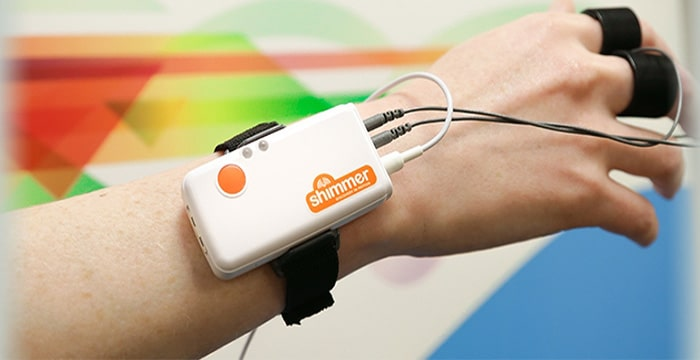Electrodermal Activity (EDA), also known as skin conductance or Galvanic Skin Response (GSR), refers to the continuous variation in the electrical properties of the skin. These variations are primarily influenced by sweat gland activity, which is controlled by the sympathetic nervous system. When experiencing emotions like stress or excitement, the autonomic nervous system triggers sweat glands, particularly on the palms and fingers, increasing skin conductance. By measuring these changes, researchers can gain insights into a person’s physiological and psychological state.
Typically, researchers measure EDA by putting two electrodes on the fingers or palm of the (non-dominant) hand.

Key components of EDA
EDA signals consist of two main components:
- Tonic EDA Level: This represents the baseline level of skin conductance, which fluctuates over time due to factors unrelated to immediate stimuli, such as ambient temperature and hydration.
- Phasic EDA Responses: These are short-term changes in skin conductance that occur in response to specific stimuli. Phasic responses are characterized by their latency, rise time, amplitude, and decay.

Application of EDA
Behavioural scientist use EDA because of its ability to provide objective, real-time data on physiological / emotional arousal. EDA measures unconscious physical responses, offering a more accurate picture of emotional reactions. It is complementary to self-report data.
EDA in NoldusHub
NoldusHub processes EDA data providing two main signals:
- EDA Tonic Level: This represents the baseline skin conductance level, measured in microsiemens (μS), which helps in understanding the overall physiological state of the participant.
- EDA Peak Rate: This measures the number of phasic skin conductance responses per minute, providing an indication of the frequency of stress or emotional arousal events.
NoldusHub utilizes EDA data in several ways:
- Monitoring Stress Responses: By analyzing the EDA Peak Rate, researchers can assess the intensity and frequency of stress or emotional arousal experienced by participants during experiments.
- Behavioral Analysis: EDA data is integrated with other physiological signals, such as heart rate and eye tracking, to provide a holistic view of participant behavior and physiological responses.
Conclusion
Electrodermal Activity (EDA) is a powerful tool in behavioral research, providing insights into physiological responses to stress and emotional stimuli.
